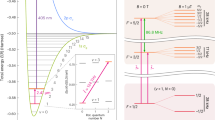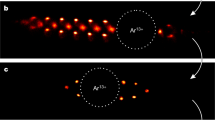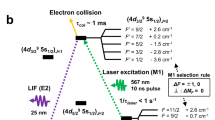Abstract
Optical spectroscopy in the gas phase is a key tool for elucidating the structure of atoms and molecules and their interaction with external fields. The line resolution is usually limited by a combination of first-order Doppler broadening due to particle thermal motion and a short transit time through the excitation beam. For trapped particles, suitable laser cooling techniques can lead to strong confinement (the Lamb–Dicke regime) and thus to optical spectroscopy free of these effects. For non-laser-coolable spectroscopy ions, this has so far only been achieved when trapping one or two atomic ions, together with a single laser-coolable atomic ion1,2. Here we show that one-photon optical spectroscopy free of Doppler and transit broadening can also be obtained with more easily prepared ensembles of ions, if performed with mid-infrared radiation. We demonstrate the method on molecular ions. We trap ~100 molecular hydrogen ions (HD+) within a Coulomb cluster of a few thousand laser-cooled atomic ions and perform laser spectroscopy of the fundamental vibrational transition. Transition frequencies were determined with a lowest uncertainty of 3.3 × 10−12 fractionally. As an application, we determine the proton–electron mass ratio by matching a precise ab initio calculation with the measured vibrational frequency.
This is a preview of subscription content, access via your institution
Access options
Access Nature and 54 other Nature Portfolio journals
Get Nature+, our best-value online-access subscription
$29.99 / 30 days
cancel any time
Subscribe to this journal
Receive 12 print issues and online access
$209.00 per year
only $17.42 per issue
Buy this article
- Purchase on Springer Link
- Instant access to full article PDF
Prices may be subject to local taxes which are calculated during checkout




Similar content being viewed by others
Data availability
Data that support the plots within this paper and other findings of this study are available from the corresponding author upon reasonable request. Source data are provided with this paper.
References
Rosenband, T. et al. Observation of the 1S0 → 3P0 clock transition in 27Al+. Phys. Rev. Lett. 98, 220801 (2007).
Chou, C. W., Hume, D. B., Thorpe, M. J., Wineland, D. J. & Rosenband, T. Quantum coherence between two atoms beyond Q = 1015. Phys. Rev. Lett. 106, 160801 (2011).
Dicke, R. H. The effect of collisions upon the Doppler width of spectral lines. Phys. Rev. 89, 472–473 (1953).
Major, F. G. & Werth, G. High-resolution magnetic hyperfine resonance in harmonically bound ground-state 199Hg ions. Phys. Rev. Lett. 30, 1155–1158 (1973).
Rosenband, T. et al. Frequency ratio of Al+ and Hg+ single-ion optical clocks; metrology at the 17th decimal place. Science 319, 1808–1812 (2008).
Derevianko, A. & Katori, H. Colloquium: Physics of optical lattice clocks. Rev. Mod. Phys. 83, 331–347 (2011).
Poli, N., Oates, C. W., Gill, P. & Tino, G. M. Optical atomic clocks. Riv. Nuovo Cim. 36, 555–624 (2013).
Ludlow, A. D., Boyd, M. M., Ye, J., Peik, E. & Schmidt, P. O. Optical atomic clocks. Rev. Mod. Phys. 87, 637–701 (2015).
Diedrich, F., Bergquist, J. C., Itano, W. M. & Wineland, D. J. Laser cooling to the zero-point energy of motion. Phys. Rev. Lett. 62, 403–406 (1989).
Lechner, R. et al. Electromagnetically-induced-transparency ground-state cooling of long ion strings. Phys. Rev. A 93, 053401 (2016).
Schmidt, P. O. et al. Spectroscopy using quantum logic. Science 309, 749–752 (2005).
Alighanbari, S., Hansen, M. G., Korobov, V. I. & Schiller, S. Rotational spectroscopy of cold and trapped molecular ions in the Lamb–Dicke regime. Nat. Phys. 14, 555–559 (2018).
Alighanbari, S., Giri, G. S., Constantin, F. L., Korobov, V. I. & Schiller, S. Precise test of quantum electrodynamics and determination of fundamental constants with HD+ ions. Nature 581, 152–158 (2020).
Chou, C. W. et al. Frequency-comb spectroscopy on pure quantum states of a single molecular ion. Science 367, 1458–1461 (2020).
Kondov, S. S. et al. Molecular lattice clock with long vibrational coherence. Nat. Phys. 15, 1118–1122 (2019).
Patra, S. et al. Proton–electron mass ratio from laser spectroscopy of HD+ at the part-per-trillion level. Science 369, 1238–1241 (2020).
Wolf, F. et al. Non-destructive state detection for quantum logic spectroscopy of molecular ions. Nature 530, 457–460 (2016).
Zhang, C. Production and Sympathetic Cooling of Complex Molecular Ions. PhD thesis, Heinrich-Heine-Universität Düsseldorf (2008).
Lakkaraju, H. S. & Schuessler, H. A. Motional side-band resonances in the microwave spectrum of stored ions. J. Appl. Phys. 53, 3967–3974 (1982).
Cutler, L. S., Giffard, R. P. & McGuire, M. D. Thermalization of 199Hg ion macromotion by a light background gas in an RF quadrupole trap. Appl. Phys. B 36, 137–142 (1985).
Prestage, J. D., Tjoelker, R. L., Dick, G. J. & Maleki, L. Ultrastable Hg+. J. Mod. Opt. 39, 221–232 (1992).
Fisk, P. T. H., Sellars, M. J., Lawn, M. A. & Coles, C. Accurate measurement of the 12.6-GHz ‘clock’ transition in trapped Yb+ ions. IEEE Trans. Ultrason. Ferroelectr. Freq. Control 44, 344–354 (1997).
Tiesinga, E., Mohr, P. J., Newell, D. B. & Taylor, B. N. Values of Fundamental Physical Constants (2019); https://physics.nist.gov/cuu/Constants/index.html
Köhler, F. et al. The electron mass from g-factor measurements on hydrogen-like carbon 12C5+. J. Phys. B 48, 144032 (2015).
Heiße, F. et al. High-precision mass spectrometer for light ions. Phys. Rev. A 100, 022518 (2019).
Rau, S. et al. Penning trap mass measurements of the deuteron and the HD+ molecular ion. Nature 585, 43–47 (2020).
Sturm, S. et al. High-precision measurement of the atomic mass of the electron. Nature 506, 467–470 (2014).
Fink, D. J. & Myers, E. G. Deuteron-to-proton mass ratio from the cyclotron frequency ratio of \({\mathrm{H}}_{2}^{+}\) to D+ with \({\mathrm{H}}_{2}^{+}\) in a resolved vibrational state. Phys. Rev. Lett. 124, 013001 (2020).
Korobov, V. I., Karr, J.-Ph., Haidar, M. & Zhong, Z.-X. Hyperfine structure in the \({\mathrm{H}}_{2}^{+}\) and HD+ molecular ions at order mα6. Phys. Rev. A 102, 022804 (2020).
Bressel, U. et al. Manipulation of individual hyperfine states in cold trapped molecular ions and application to HD+ frequency metrology. Phys. Rev. Lett. 108, 183003 (2012).
Biesheuvel, J. et al. High-precision spectroscopy of the HD+ molecule at the 1-p.p.b. level. Appl. Phys. B 123, 23 (2016).
Schiller, S. & Korobov, V. Test of time-dependence of the electron and nuclear masses with ultracold molecules. Phys. Rev. A 71, 032505 (2005).
Germann, M., Tong, X. & Willitsch, S. Observation of dipole-forbidden transitions in sympathetically cooled, state-selected, homonuclear diatomic molecular ions. Nat. Phys. 10, 820–824 (2014).
Schiller, S., Bakalov, D. & Korobov, V. I. Simplest molecules as candidates for precise optical clocks. Phys. Rev. Lett. 113, 023004 (2014).
Karr, J.-Ph. \({\mathrm{H}}_{2}^{+}\) and HD+: candidates for a molecular clock. J. Mol. Spectrosc. 300, 37–43 (2014).
Wiens, E., Nevsky, A. Y. & Schiller, S. Resonator with ultrahigh length stability as a probe for equivalence-principle-violating physics. Phys. Rev. Lett. 117, 271102 (2016).
Chen, Q.-F. et al. A compact, robust and transportable ultra-stable laser with a fractional frequency instability of 1 × 10−15. Rev. Sci. Instrum. 85, 113107 (2014).
Bakalov, D., Korobov, V. I. & Schiller, S. High-precision calculation of the hyperfine structure of the HD+ ion. Phys. Rev. Lett. 97, 243001 (2006).
Korobov, V. I., Hilico, L. & Karr, J.-Ph. Fundamental transitions and ionization energies of the hydrogen molecular ions with few ppt uncertainty. Phys. Rev. Lett. 118, 233001 (2017).
Aznabayev, D. T., Bekbaev, A. K. & Korobov, V. I. Leading-order relativistic corrections to the rovibrational spectrum of \({\mathrm{H}}_{2}^{+}\) and HD+ molecular ions. Phys. Rev. A 99, 012501 (2019).
Korobov, V. I., Koelemeij, J. C. J., Hilico, L. & Karr, J.-Ph. Theoretical hyperfine structure of the molecular hydrogen ion at the 1-ppm level. Phys. Rev. Lett. 116, 053003 (2016).
Bakalov, D., Korobov, V. & Schiller, S. Magnetic field effects in the transitions of the HD+ molecular ion and precision spectroscopy. J. Phys. B 44, 025003 (2011).
Bakalov, D. & Schiller, S. The electric quadrupole moment of molecular hydrogen ions and their potential for a molecular ion clock. Appl. Phys. B 114, 213–230 (2014).
Schiller, S., Bakalov, D., Bekbaev, A. K. & Korobov, V. I. Static and dynamic polarizability and the Stark and blackbody-radiation frequency shifts of the molecular hydrogen ions \({\mathrm{H}}_{2}^{+}\), HD+ and \({\mathrm{D}}_{2}^{+}\). Phys. Rev. A 89, 052521 (2014).
Hall, J. L., Bordé, C. J. & Uehara, K. Direct optical resolution of the recoil effect using saturated absorption spectroscopy. Phys. Rev. Lett. 37, 1339–1342 (1976).
Salomon, C., Bréant, C., Bordé, C. & Barger, R. Ramsey fringes using transitions in the visible and 10-μm spectral regions—experimental methods. J. Phys. Colloq. 42, 3–14 (1981).
Bagayev, S. N., Baklanov, A. E., Chebotayev, V. P. & Dychkov, A. S. Superhigh resolution spectroscopy in methane with cold molecules. Appl. Phys. B 48, 31–35 (1989).
Cheng, W.-Y., Chen, L., Yoon, T. H., Hall, J. L. & Ye, J. Sub-doppler molecular-iodine transitions near the dissociation limit (523–498 nm). Opt. Lett. 27, 571–573 (2002).
Bagayev, S. N. et al. Second-order doppler-free spectroscopy. Appl. Phys. B 52, 63–66 (1991).
Markus, C. R., Kocheril, P. A. & McCall, B. J. Sub-doppler rovibrational spectroscopy of the ν1 fundamental band of D2H+. J. Mol. Spectrosc. 355, 8–13 (2019).
Mills, A. A. et al. Ultra-sensitive high-precision spectroscopy of a fast molecular ion beam. J. Chem. Phys. 135, 224201 (2011).
Wing, W. H., Ruff, G. A., Lamb, W. E. & Spezeski, J. J. Observation of the infrared spectrum of the hydrogen molecular ion HD+. Phys. Rev. Lett. 36, 1488–1491 (1976).
Coe, J. V. et al. Sub-doppler direct infrared laser absorption spectroscopy in fast ion beams: the fluorine hyperfine structure of HF+. J. Chem. Phys. 90, 3893–3902 (1989).
Markus, C. R., Thorwirth, S., Asvany, O. & Schlemmer, S. High-resolution double resonance action spectroscopy in ion traps: vibrational and rotational fingerprints of \({\mathrm{CH}}_2{\mathrm{NH}}_{2}^{+}\). Phys. Chem. Chem. Phys. 21, 26406–26412 (2019).
Roth, B., Koelemeij, J. C. J., Daerr, H. & Schiller, S. Rovibrational spectroscopy of trapped molecular hydrogen ions at millikelvin temperatures. Phys. Rev. A 74, 040501 (2006).
Koelemeij, J. C. J., Noom, D. W. E., de Jong, D., Haddad, M. A. & Ubachs, W. Observation of the \(v^{\prime} =8\leftarrow v=0\) vibrational overtone in cold trapped HD+. Appl. Phys. B 107, 1075–1085 (2012).
Biesheuvel, J. et al. Probing QED and fundamental constants through laser spectroscopy of vibrational transitions in HD+. Nat. Commun. 7, 10385 (2016).
Calvin, A. T. et al. Rovibronic spectroscopy of sympathetically cooled 40CaH+. J. Phys. Chem. A 122, 3177–3181 (2018).
Liao, C.-C., Lien, Y.-H., Wu, K.-Y., Lin, Y.-R. & Shy, J.-T. Widely tunable difference frequency generation source for high-precision mid-infrared spectroscopy. Opt. Express 21, 9238–9246 (2013).
Takahata, K. et al. Absolute frequency measurement of sub-doppler molecular lines using a 3.4-μm difference-frequency-generation spectrometer and a fiber-based frequency comb. Phys. Rev. A 80, 032518 (2009).
Sera, H. et al. Sub-doppler resolution mid-infrared spectroscopy using a difference-frequency-generation source spectrally narrowed by laser linewidth transfer. Opt. Lett. 40, 5467–5470 (2015).
Hansen, M. G., Magoulakis, E., Chen, Q.-F., Ernsting, I. & Schiller, S. Quantum cascade laser-based mid-IR frequency metrology system with ultra-narrow linewidth and 1 × 10−13-level frequency instability. Opt. Lett. 40, 2289–2292 (2015).
Argence, B. et al. Quantum cascade laser frequency stabilization at the sub-Hz level. Nat. Photon. 9, 456–460 (2015).
Borri, S. et al. High-precision molecular spectroscopy in the mid-infrared using quantum cascade lasers. Appl. Phys. B 125, 18 (2019).
Acknowledgements
We are indebted to E. Wiens for assistance with the frequency comb measurements. We are very grateful to J.-Ph. Karr for communicating the value of \({\mathcal{E}}^{\prime}_1\) before publication. This work has received funding from the European Research Council (ERC) under the European Union’s Horizon 2020 research and innovation programme (grant no. 786306, ‘PREMOL’), from the Deutsche Forschungsgemeinschaft (Schi 431/23-1) and from both DFG and the state of Nordrhein-Westfalen via grant no. INST-208/737-1 FUGG. I.V.K. was partly supported by FP7-2013-ITN ‘COMIQ’ (grant no. 607491). V.I.K. acknowledges support from the Russian Foundation for Basic Research under grant no. 19-02-00058-a.
Author information
Authors and Affiliations
Contributions
I.V.K., M.G.H. and S.S. developed the laser system. I.V.K., S.A. and G.S.G. performed the experiments and analysed the data. I.V.K., S.S. and V.I.K. performed theoretical calculations. S.S. conceived the study, supervised the work and wrote the manuscript. All authors contributed to editing of the manuscript.
Corresponding author
Ethics declarations
Competing interests
The authors declare no competing interests.
Additional information
Peer review information Nature Physics thanks the anonymous reviewers for their contribution to the peer review of this work.
Publisher’s note Springer Nature remains neutral with regard to jurisdictional claims in published maps and institutional affiliations.
Supplementary information
Supplementary Information
Supplementary Figs. 1–3 and Table 1.
Supplementary Data SI Fig. 2
Numerical data used to generate the graphs in Fig. 2 of the Supplementary Information.
Supplementary Data SI Fig. 3
Numerical data used to generate the graphs in Fig. 3 of the Supplementary Information.
Source data
Source Data Fig. 2
Numerical data used to generate the graphs in Fig. 2 of the main text.
Source Data Fig. 3
Numerical data used to generate the graphs in Fig. 3 of the main text.
Rights and permissions
About this article
Cite this article
Kortunov, I.V., Alighanbari, S., Hansen, M.G. et al. Proton–electron mass ratio by high-resolution optical spectroscopy of ion ensembles in the resolved-carrier regime. Nat. Phys. 17, 569–573 (2021). https://doi.org/10.1038/s41567-020-01150-7
Received:
Accepted:
Published:
Issue Date:
DOI: https://doi.org/10.1038/s41567-020-01150-7
This article is cited by
-
Laser spectroscopy of a rovibrational transition in the molecular hydrogen ion \({\mathbf{H}}_{\mathbf{2}}^{\mathbf{+}}\)
Nature Physics (2024)
-
Test of charged baryon interaction with high-resolution vibrational spectroscopy of molecular hydrogen ions
Nature Physics (2023)
-
Absolute frequency metrology of buffer-gas-cooled molecular spectra at 1 kHz accuracy level
Nature Communications (2022)
-
A 16-parts-per-trillion measurement of the antiproton-to-proton charge–mass ratio
Nature (2022)



